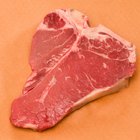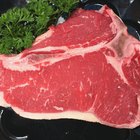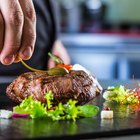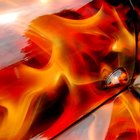
Restaurants have heavy-duty ranges, special grill pans, even butane torches to cook meat, but you don't have to have any of that equipment to turn out a mouth-watering steak. Oiling the pan helps prevent the steak from sticking -- resulting in a tasty crust. If you're out of oil, or just choose not to add any additional fat to the steak, your steak can still have that crisp brown crust enclosing juicy tenderness.
Prepare the Meat
Season the steak with your favorite rub or use a combination of garlic powder, onion powder, dried herbs and spices. Marinating the steak for a few hours, even overnight is another option to increase moisture. Bring the steak out of the refrigerator at least 30 minutes before you plan to cook it, so it comes to room temperature. Keep it loosely covered.
No Oil Needed
If you don't have oil, you can also use bacon drippings, lard or shortening. Butter has a lower smoking point than oil, so if you want to use butter you'll have to clarify it first. Melt it until it bubbles around the edges. Put the melted butter into a tempered glass or metal container. When the butter becomes solid, pour off the liquid. Another option is to use the fat of the steak itself, if it has some. Hold the fatty end down against a hot pan. Use tongs so you don't burn yourself or pierce the meat. The fat will melt.
Grill It Up
Grilling the steak over hot coals or a gas grill requires no oil, but the grill has to be hot enough first. Hold your hand about 5 inches above the grill. If you can't keep your hand over the grill for more than two seconds, it's medium hot. Another tip to keep the steak from sticking to the grill is not to move it until you're ready to turn it over. How long this takes depends on how well done you like the steak.
Under the Broiler
The broiler is like a reverse grill. On a grill, the heat comes from below the steak. Any juices or fat drip away from the steak into the hot coals. The broiler provides heat from above. Using a ridged grill pan or the perforated broiler pan keeps the steak from sitting in its own juices. The fat drips down into the ridges as well. A 1-inch-thick steak will reach 145 degrees Fahrenheit in 14 to 18 minutes. Turn the steak over at the halfway point.
Oven Roasted
Restaurant chefs often sear a steak in a hot frying pan and finish the steak in the oven. There isn't any reason you can't do the same. Put an oven-proof pan in a hot oven -- 475 F. After 10 minutes put the steak in the pan and return it to the oven. Let the steak cook until the oven goes back up to 475 F. Then lower the heat to 400 F. Cook the steak to at least 145 F to prevent foodborne illness.
Related Articles

How to Broil Strip Steak

Ways to Cook T-Bones Indoors

How to Cook Angus Beef Steak

How to Cook Deer Steaks in the Oven on ...

How to Cook London Broil

How to Cook a Thresher Shark Steak

Grilling Instructions for Rib-Eye Steak

How to Cook Steak on FlavorWave

How to Cook Center Cut Chuck Steak

How Hot Should a Grill Be for Steaks?

Easy Ways to Cook Pork Steak

How to Broil Filet Mignon Wrapped in ...

How to Cook Steak on a Baking Sheet

How to Bake Beef Steak to Melt in Your ...

How to Grill a Ribeye on a Weber Q

How to Cook Ultra Thin Sirloin
How to Cook Roast Beef in a Cast-Iron ...

How to Make Pan-Seared Baked Steak

Grilling a Top Sirloin Filet in a Cast ...

How to Cook Thin Sirloin Tip Steaks on ...
References
- License to Grill; Chris Schlesinger and John Willoughby
- Betty Crocker: Timetable for Broiling Meats
Writer Bio
Katie Jensen's first book was published in 2000. Since then she has written additional books as well as screenplays, website content and e-books. Rosehill holds a Master of Business Administration from Arizona State University. Her articles specialize in business and personal finance. Her passion includes cooking, eating and writing about food.
Photo Credits
Jupiterimages/liquidlibrary/Getty Images